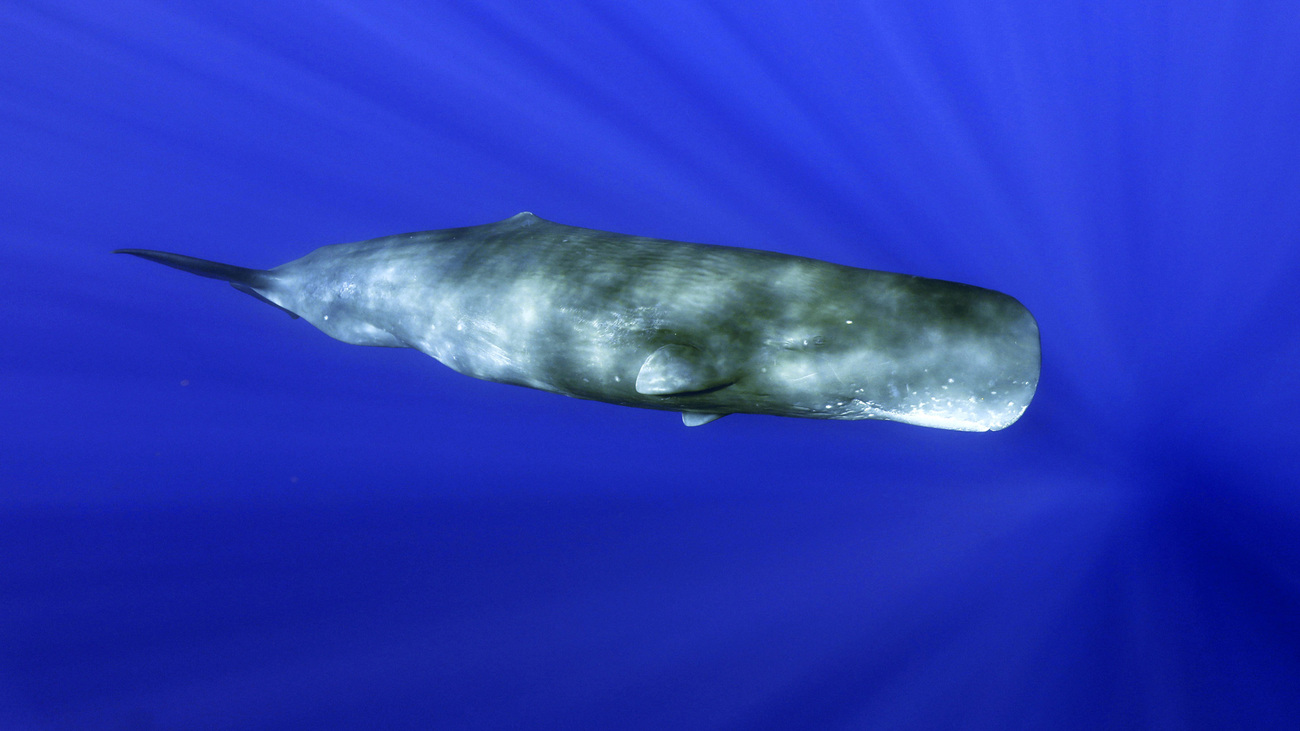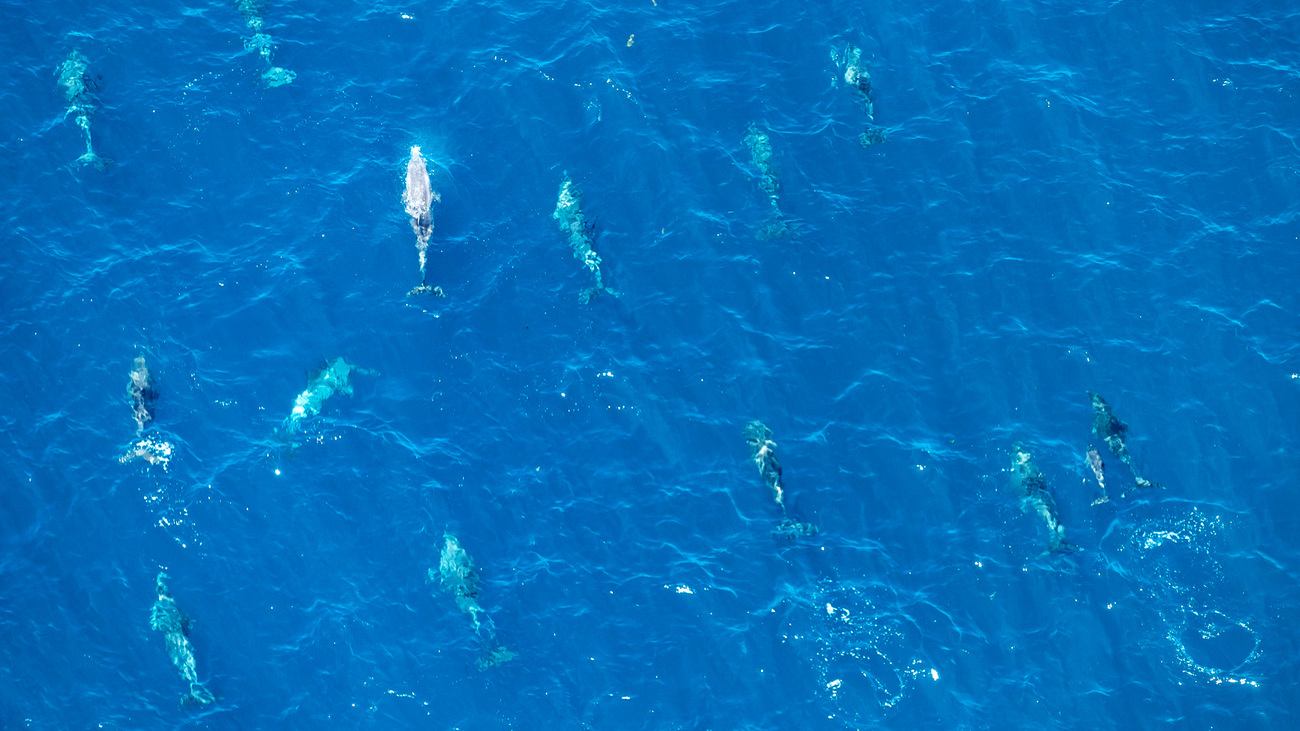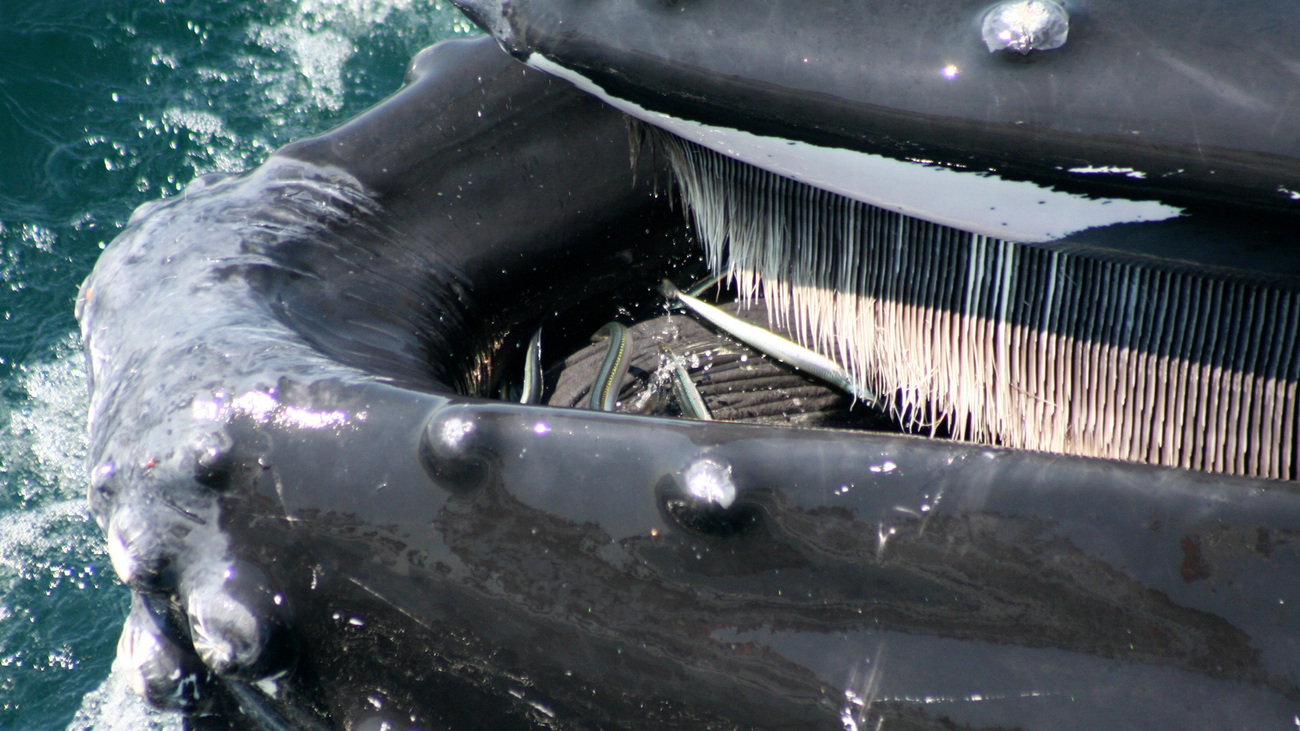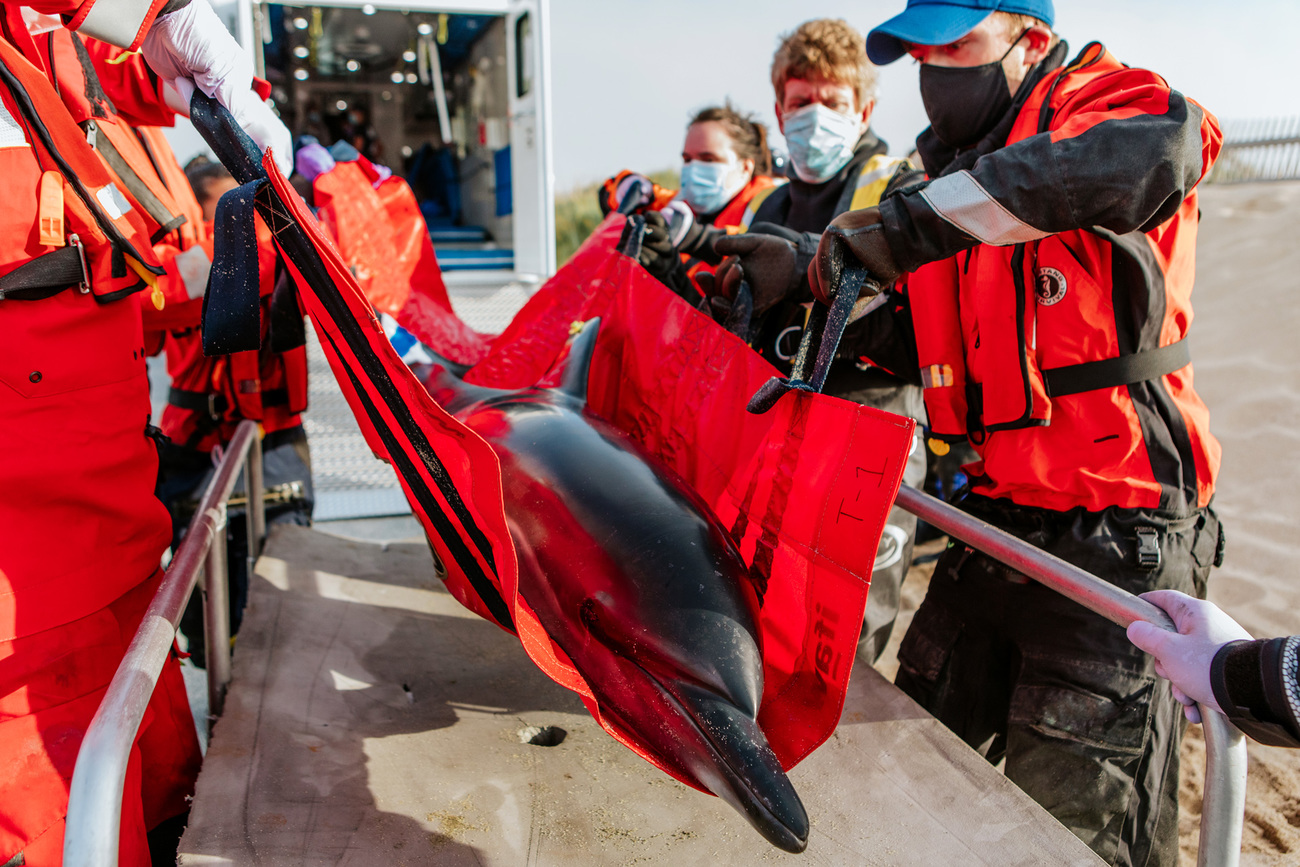Stranded Marine Mammal Rescue - Global
When the tide is low, the stakes are high for marine mammalsWhales and dolphins have a lot in common. They’re both intelligent, carnivorous aquatic mammals that share physical characteristics, with streamlined bodies, blowholes, and fins. So, what is the difference between dolphins and whales? Are dolphins whales? And are whales dolphins?

As we explain below, you can’t rely on the name of a whale or dolphin to determine its taxonomic classification. Let’s examine dolphin versus whale characteristics and determine which animals belong to each category.
What are whales?
Whales are warm-blooded mammals that live in the ocean, breathe air, and nurse their young, just like humans. The scientific name for all whales, dolphins, and porpoises is Cetacea. There are 90 different species of whale, which can be divided into two categories: baleen whales and toothed whales.
Baleen whales include blue whales (Balaenoptera musculus), bowhead whales (Balaena mysticetus), fin whales (Balaenoptera physalus), and grey whales (Eschrichtius robustus), among others. Their mouths are filled with baleen—fringed plates made from keratin that filter out food, including small fish, krill, and tiny zooplankton from seawater.
As their name suggests, toothed whales—like belugas (Delphinapterus leucas) and sperm whales (Physeter macrocephalus)—have teeth. They eat a different diet to baleen whales, hunting fish, squid, and other sea creatures.

What are dolphins?
Dolphins are also marine mammals and are classified under Cetacea, just like whales and porpoises. They live in both freshwater and saltwater environments, including oceans, lakes, and rivers.
There are 40 species of dolphin. These include the bottlenose dolphin (Tursiops truncatus), the Indus river dolphin (Platanista minor), and the Atlantic humpback dolphin (Sousa teuszii).
Dolphins are known for their intelligence and highly social behaviour. They often live in groups—called pods—that hunt collaboratively and communicate through vocalisations and body language. Like whales, dolphins are carnivorous. They eat fish, squid, and sometimes crustaceans.
So, are dolphins whales?
All dolphins are, in fact, whales. Scientifically, all whales, dolphins, and porpoises are classified as Cetacea. Within the Cetacea group—called an infraorder, as it falls within the order Artiodactyla— there are two subgroups: baleen whales and toothed whales.
Dolphins are a type of toothed whale. Dolphins are simply smaller whales, with killer whales, also known as orcas, being the largest type of dolphin.
And are whales dolphins?
All dolphins are whales. But not all whales are dolphins. The sperm whale and the narwhal, for example, aren’t classified as dolphins. The animals that are considered dolphins fall into the following families:
- Delphinidae (oceanic dolphins)
- Platanistidae (Indian river dolphins)
- Iniidae (New World river dolphins)
- Pontoporiidae (brackish dolphins)
- Lipotidae (Chinese river dolphins)
What characteristics do dolphins share with whales?
Dolphins and whales have several characteristics in common.
Mammalian characteristics
Dolphins and whales are both mammals, meaning they’re warm-blooded, can’t breathe underwater, give birth to live offspring, and nurse their young.
Appearance
Both whales and dolphins have streamlined bodies that help them move efficiently through the water. Most species have a dorsal fin on their back and pectoral flippers on either side of their bodies. They also have tail flukes that they use to propel themselves through the water and a thick layer of blubber beneath their skin that helps insulate them against cold temperatures.
Breathing
Both whales and dolphins have at least one blowhole. They breathe air through this blowhole at the surface and hold their breath while underwater.
To ensure they don’t drown while sleeping, both whales and dolphins can shut down just one half of their brain when they’re asleep. The awake part of the brain ensures they rise to the surface to breathe when necessary. After a while, the sides of the brain swap roles, so both sides get a chance to rest.
Intelligence, social behaviours, and communication
Dolphin and whale intelligence is renowned. Both have large brains, demonstrate problem-solving and teaching skills, and display signs of emotions like empathy, grief, joy, and playfulness. They also establish strong social bonds with one another.
Their intelligence helps with communication. Both dolphins and whales produce vocalisations to communicate with one another. They also take good care of their young, nursing their calves for over a year.

What’s the difference between dolphins and whales?
Whales and dolphins have a lot in common. But there are also some key differences between these two groups of animals.
Taxonomic classification
Taxonomy classifies whales, dolphins, and porpoises under the infraorder Cetacea, which means they’re called cetaceans. This group is divided into two subgroups—baleen whales (Mysticeti) and toothed whales (Odontoceti). There are approximately 14 species of baleen whales and 75 species of toothed whales, which include dolphins and porpoises as well as larger animals like sperm whales, belugas, and narwhals.
Fins
Most dolphins and other toothed whales have a well-defined dorsal fin on their back. They use this fin for stability when swimming. Baleen whales have much smaller dorsal fins, usually located near the tail fin.
Beluga whales (a member of the toothed whale group) are an exception because, unlike other toothed whales and dolphins, they don’t have dorsal fins.
Teeth
Baleen whales don’t have teeth. Instead, they have baleen plates that filter krill and plankton from seawater. Dolphins and other toothed whales have cone-shaped teeth, which they use to grasp their prey.

Blowholes
Both baleen whales and dolphins have blowholes. But baleen whales have two blowholes, while toothed whales (and therefore dolphins) have just one.
Whales can generally hold their breath for longer than dolphins. Some whale species can stay underwater for up to two hours. This ability allows them to dive into the deep ocean in search of food. Bottlenose dolphins, in comparison, can only hold their breath for around seven minutes.
Body shape and size
Dolphins are smaller and leaner than baleen whales. They have torpedo-shaped bodies that help them move quickly through the water in pursuit of their prey. The largest dolphin is the orca, also known as the killer whale. Adult male orcas can measure around 8.2 metres (27 feet). Male orcas weigh twice as much as females—up to 6,000 kilograms (13,300 pounds).
In comparison, baleen whales tend to be slower and bigger, which is why they’re nicknamed ‘the great whales’. The biggest baleen whale is the blue whale. It can grow up to 30 metres (98 feet) long and weigh more than 180,000 kilograms (200 tons).
Habitat
Baleen whales only live in the ocean. But some dolphin species live in freshwater habitats, including lakes and rivers. Some dolphins also move between marine and freshwater environments.
Lifespan
Baleen whales tend to live longer than dolphins. It’s thought that bowhead whales can live up to 200 years old. Blue whales live between 80 and 90 years. Bottlenose dolphins live for around 40 years. The average lifespan for an orca is 30 to 50 years.
Diet
In terms of diet, baleen whales eat smaller food at a larger volume than dolphins, eating tons of krill, plankton, and small fish.
Dolphins eat larger prey, including various species of fish, squid, jellyfish, crustaceans, and octopus. Their diet depends on where they live and what is available.
Echolocation
Dolphins use echolocation to track down their prey. They emit a clicking sound through the water and use the sound waves that bounce back at them to find food. Dolphins also use echolocation to communicate with one another.
Baleen whales can’t echolocate. But they do communicate with each other through their whale ‘song’—deep, low calls that can travel huge distances across the ocean.
Behaviour
Both whales and dolphins are social creatures. But dolphins tend to travel in much larger social groups. Depending on the species, a typical dolphin pod consists of 10 to 15 individuals, although super-pods of over 1,000 animals have been observed in areas with an abundance of food.
Baleen whales tend to travel alone or in smaller groups. They sometimes congregate to feed, breed, or migrate and often come together during the calving season.
However, because their noises can travel such long distances—over thousands of kilometres—it could be that baleen whales stay in contact with one another even when they are geographically far apart.
Both whales and dolphins are endangered
Like many animals today, dolphins and whales are threatened by climate change and human activity. Man-made marine noise causes stress and interferes with whale and dolphin communication, climate change is affecting food availability and ocean chemistry, while vessel strikes and entanglement in fishing nets are also pushing species to the brink of extinction.
Vaquitas, the smallest cetaceans, are critically endangered. As of 2024, there are now only 8 to 13 mature individuals left in the wild. The North Atlantic right whale, Atlantic humpback dolphin, and Rice’s whale are all critically endangered, too.
That’s why IFAW is working hard with partners and communities around the world to protect our ocean and the animals that call it home.

We’ve pioneered field health assessments and treatments for stranded dolphins and whales, helping animals survive and thrive once they’re released back into the wild. We also share our knowledge of rescuing stranded and entangled marine animals with other wildlife professionals around the world.
In Kenya, we’re working to safeguard coastal ecosystems. We’re improving waste management, helping local communities reduce their reliance on marine resources, and establishing greater protections within locally managed marine areas (LMMA).
IFAW is also lobbying for slower ship speeds in EU waters to make the oceans quieter and safer for marine mammals. And we’re working to end commercial whaling through public awareness campaigns and governmental lobbying.
Related content
Our work can’t get done without you. Please give what you can to help animals thrive.